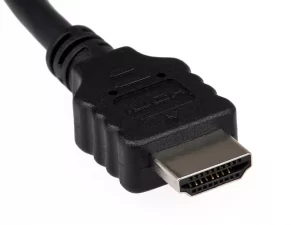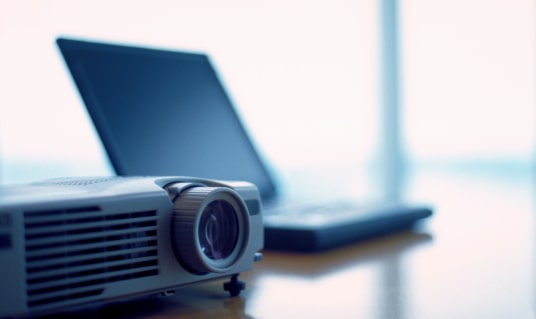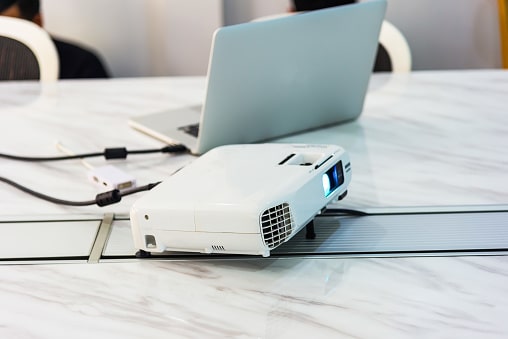Laptop and projector – both are widely used devices in the modern world. They both have their specific advantages and disadvantages. If we compare laptops to projectors, we must say that laptops win because they offer much more features such as higher performance or portability. On the other hand, projectors will always stay connected to a power source to never run out of batteries. Also, they are less expensive than laptops.
Laptops can be connected to projectors to increase their functionalities and to share files or spread presentations with other people.
There are two methods you can use when connecting a laptop to a projector: VGA Vs HDMI
VGA Connection
The first method is VGA (Video Graphics Array), and it has been widely used for a long time. It is the standard connection if you want to connect a laptop to a projector. With this method, you will need an HDMI to VGA adapter and an audio cable (optional).
HDMI Connection

The second method is the HDMI (High-Definition Multimedia Interface). HDMI is the newest technology used to connect devices. With this method, you won’t need any audio cable because the sound will be streamed via HDMI. Also, you can use a simple HDMI cable to connect the laptop and projector. You won’t need adapters or converters with an HDMI connection.
For best projectors under $1000, you can consider wireless connection.
With this guide, you will learn how to connect a projector to your laptop by using an HDMI cable and VGA cord (depends on the type of projector), but first, you need to know these things:
Things to Know Before Connecting Laptop with Projector
– Most projectors require an external power supply. So it will need a power source, which is usually with a wall outlet.
– most projectors have VGA/RGB INPUT which is the best connection to your laptop for projecting your videos, presentations, pictures, or anything else. So you need to know how this looks on your projector and what cable goes where (VGA cable to RGB port of projector).
– If you don’t use VGA/RGB INPUT, then most projectors have a USB connection. For this one, you need a laptop with VGA or HDMI port and a USB cable.
– Some projectors have s-video input (so you can connect it to your tv and project from there). and also, they mostly have audio in which you can connect to your laptop
– Some projectors have HDMI INPUT, so if you want to connect your laptop with an HDMI port, you must use this connection. There is no additional configuration needed
– Some projectors even have Ethernet/LAN, which you can connect with a VGA cable (similar to VGA/RGB) and also use a network cable to connect with your laptop or computer
Why is My Laptop not connecting to the Projector?
Here are some common reasons:
– Maybe you are using the wrong input. to check this, simply press the input or source buttons on your remote control or projector to see what type of connection is available
– Most projectors have one USB port, so if you want to connect with the projector via USB, then it must be plugged in and active
– Most projectors also have VGA, and some of them also have USB and s-video (if you want to use these connections, then it must be plugged in and active)
How Do I get My Computer to Recognize My Projector?

If your laptop doesn’t recognize your projector after connecting them using one of the methods mentioned above, you may need to make some changes in your display settings. Here is how:
– go to the control panel, choose hardware and sound
– Click on the “change display setting” link under the “display” category
– If there are two or more display devices, then you can use the drop-down menu at the top to choose the device that you want
– choose a projector and apply all changes.
Also, remember to press “apply” after each change in your settings.
How Do I know if My Laptop is Projecting?
It’s simple, look for a bit of light which is usually called LED on your laptop. It should be glowing after you connect your projector to your computer.
How do I connect Windows 10 to a Projector?<H2>
There are two methods:
– First method, you need to connect the projector to your laptop with an HDMI cable and also use a USB cable
– Second method, go to Action Center and look for the Project button. Click on it and select “Connect Projector.” Windows 10 will search for your projector automatically if it has an HDMI port
Conclusion:
The HDMI connection is the newest and most popular method for connecting devices because it’s supported with almost every device, even smartphones, and tablets. VGA/RGB has been endorsed with projectors since the 80s and is still very common in some models, but the drawback of this connection is that you will need an HDTV (if you want to project on a big screen). USB connection is suitable for connecting devices that have a USB port only. At last, s-video and network cable connections are not so popular anymore but still supported with some projectors.
